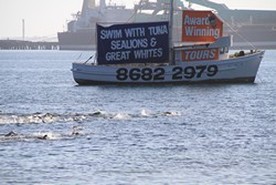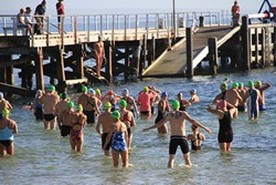|
|
Open Water SwimmingOpen water swimming takes place in outdoor bodies of water such as open oceans, bays, lakes, rivers or reservoirs. The equipment allowed in a race depends on the race organizers. For example, races may have divisions for wetsuits and/or relays; may require escort boats or kayakers; and may require specifically colored swim caps.
Sighting : When covering large distances, swimmers may head off course due to current, waves, wind, and poor visibility. Typically, buoys are stationed periodically across a large expanse to provide guidance. However, buoys are often invisible due to interference from choppy water and reduced visibility through goggles. Swimmers are encouraged to 'triangulate' by looking for two aligned, easily visible objects on land that are directly behind the destination (such as the end of a jetty as it lines up with a hilltop), and to make sure they continue to appear aligned during the race. Drafting : This is the technique of following another swimmer so closely that water resistance is reduced. When swimming closely alongside or behind a swimmer in the lead swimmer's wake, resistance is reduced and the amount of effort to swim at the same speed is correspondingly reduced. In calmer conditions, or when facing surface chop, swimmers can also significantly benefit from swimming immediately behind or closely alongside a swimmer of comparable or faster speed. Not all race organizers permit drafting, and swimmers can run the risk of disqualification if they are caught. Beach Starting and Exiting : In shallow water, it is quicker to high-step into the water and at hip depth, begin dolphining through the water. Before the race, check the nature of the bottom to determine if it is rippled, which can cause an ankle sprain if you high-step across an uneven surface. Dolphining is to dive forward hands first into the water and angle down to the bottom, press against the sand to begin coming up, and dive up and over the water again. In heavy surf conditions, dive deep and grab sand to get under a crashing wave. Upon entry and when circling buoys, swimmers will often be in a very crowded environment and may be jostled as swimmers climb over one another to get to open space and create an advantage. |
Tunarama Swim ThruEach year the West Coast Swimming Club have representative swimmers compete in the annual Swim Thru event during our January Tunarama Celebrations. Swimmers begin at the Port Lincoln Town Jetty and swim parallel to the beach rounding two bouys at the Port Lincoln Yacht Club before returning to the jetty over a distance of 1000m. Both the fastest female and fastest male are often either current or previous West Coast Swimming Club members!
|



